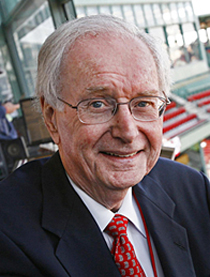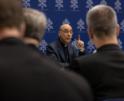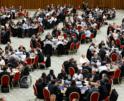
Culture
Both Slaughter and DiMaggio were baseball savants in their playing days, aware of every little detail they might use to their advantage.

Flavin
Dom DiMaggio, my boyhood hero and lifelong role model, died 11 years ago this week, so I've been thinking a lot about him lately. He opened more doors for me and gave me more lifetime memories than I can count.
This is one of those memories.
One day about a quarter of a century ago, as we were awaiting the start of a celebrity golf tournament, we spotted Enos Slaughter, the old St. Louis Cardinal, sitting in a golf cart. Dom, who knew Slaughter only casually and hadn't seen him in years, walked over, stuck out his hand and said, "Hello, Enos." Slaughter's face lit up in recognition, and he said, "Dom! Come sit with me." Dom climbed into the cart beside him, and the first thing Slaughter said was, "You know, I never would have tried it if you were still in the game."
Dom knew immediately what Slaughter referred to; it was a game that had been played a half century before. He laughed and said, "If you had tried it, I'd have had you by 20 feet."
Just like that, the two of them, both then in their 80s, were transported back to a time when they were young, when their teams faced off in the World Series, and they were the two players on which the outcome would depend.
The date was Oct. 15, 1946, the site was Sportsman's Park in St. Louis, and it was game seven of the World Series between the Red Sox and the Cardinals. In the top of the eighth, with two men on and two out, the Red Sox trailing, three to one, Dom, who had driven in the first Red Sox run with a sacrifice fly, cracked a long drive between the outfielders in right center. It drove home both runners and tied the score. Knowing that the St. Louis right fielder, who was Slaughter, was nursing a sore throwing arm, DiMaggio was thinking triple; but as he rounded first base at top speed, he felt a muscle pop in his right leg. He managed to hobble safely into second but had to be removed from the game. He was run for by journeyman Leon Culberson who would also replace him in centerfield.
As they sat together in a golf cart some 50 years later, Slaughter said, "If that ball you'd hit had been two feet farther toward center field, it would have been a home run." Dom's ears perked up; he said he'd never heard that before, but Enos explained that the 25 foot screen protecting the Sportsman's Park bleachers in short right field stretched only to right center and that Dom's drive had almost missed it. Dom's head had been down as he concentrated on going for three bases, and he hadn't seen where it hit the screen.
A somewhat nerdy onlooker (that would be me) who had been hanging on every word of the conversation immediately began calculating in his mind what would have happened if Dom's drive had in fact been two feet closer to center. It would have been a three run homer giving the Sox the lead. Dom would have gone into a home run trot and he wouldn't have pulled a muscle. He would have been playing centerfield as the dramatic events in the bottom of the inning unfolded, and the Red Sox would in all probability have won the 1946 World Series.
As it was, Culberson was in center in the bottom of the eighth when Slaughter led off with a single. Two outs later, he was still on first base when Harry Walker came up to the plate. From the dugout DiMaggio, knowing Walker, a left-handed batter, was an opposite field hitter, frantically tried to wave Culberson over to left center, to no avail. With the count two and one, Slaughter, who knew he had to get into scoring position, took off with the pitch. Sure enough, Walker cracked a line drive base hit to left center. By the time Culberson retrieved the ball, Slaughter was already near third and moving like a runaway train. Culberson, never suspecting that Enos would have the audacity to keep going, casually lobbed the ball into shortstop Johnny Pesky, who hesitated for just a moment before firing home. Too late. Slaughter easily scored the game's, and the series', winning run. "Slaughter's mad dash," as it became known, was one of the most dramatic plays in World Series history.
Up in the press box, there was confusion. This was long before the days of instant replays (the '46 series would be the last one not televised), and no one was sure what had happened to allow Slaughter to score. It was agreed that it must have been because Pesky held the ball. It was in fact Culberson's casual lob that did the damage, just as, 73 years later, it was a casual lob by a right fielder that allowed Mookie Betts to score from first on a single with the game-winning run on his final day as a Red Sox.
Both Slaughter and DiMaggio were baseball savants in their playing days, aware of every little detail they might use to their advantage. DiMaggio was aware that Slaughter's sore elbow meant he wouldn't be able to get much on his throw in the top of the eighth, which is why he was trying to leg out a triple when he pulled up lame. And Slaughter was aware that DiMaggio, the premiere defensive outfielder in the American League and the possessor of a powerful throwing arm, was no longer in the game in the bottom of the eighth, and that he might be able to take advantage of Dom's replacement.
Scores of golfers were milling around that day a quarter of a century ago as they waited for the shotgun start of a tournament. Few if any of them were aware that the two old men sitting side by side in one of the carts had been the main contributors to one of baseball's most famous games. I was the only one who was privileged to listen in on their conversation as they relived that long-ago day when they had made baseball history. And it happened because I had the good fortune in my life to be befriended by Dom DiMaggio.
Call me lucky.
- Dick Flavin is a New York Times bestselling author; the Boston Red Sox "Poet Laureate" and The Pilot's recently minted Sports' columnist.
Recent articles in the Culture & Events section
-
'Dignitas' and the mediaRussell Shaw
-
Scripture Reflection for April 14, 2024, Third Sunday of EasterDeacon Greg Kandra
-
St. Helena's House is established in the South EndThomas Lester
-
Is this synodality?Russell Shaw
-
Poking the hornet's nest of IVFFather Tadeusz Pacholczyk


















